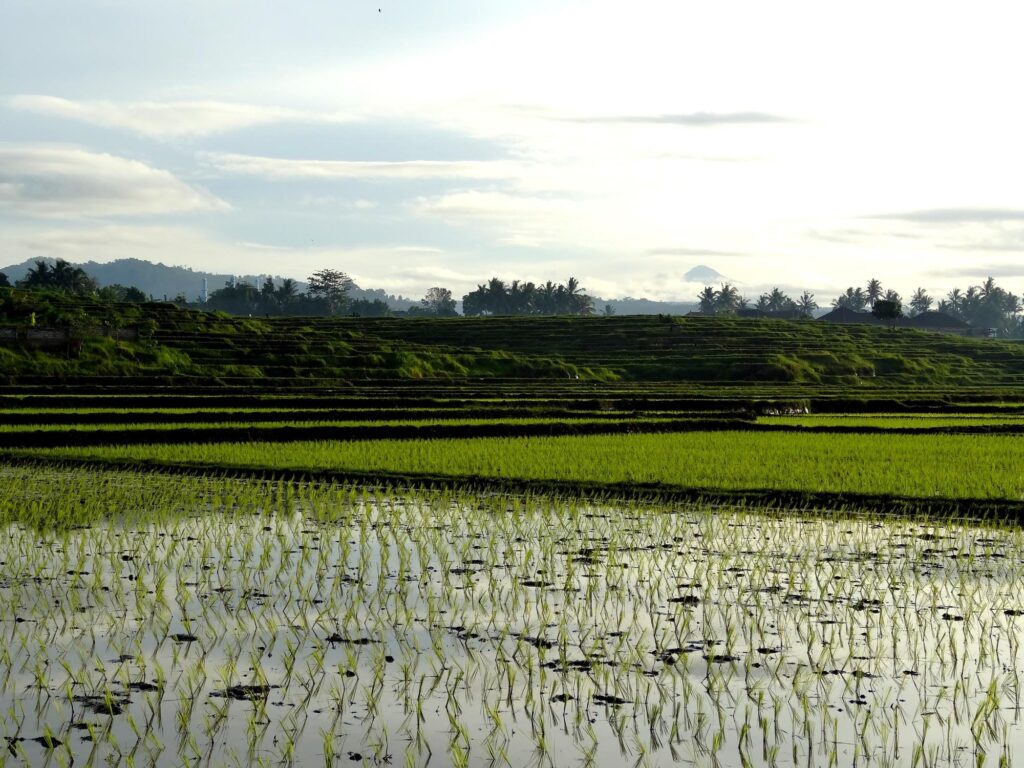The Japanese Countryside: A Myriad of Rice Paddies
Take a drive through the countryside in Japan, and you’re bound to come across gleaming fields of rice paddies at some point along the way. Once the rice planting season begins, these paddies are filled to the brim with water and rows of brilliant, green seedlings line the landscape as far as the eye can see.
Having grown up in Alberta, I’m used to seeing vast fields of wheat and canola all over the place whenever summer rolls around. So, suddenly finding myself in the middle of all these funky rice paddies made for a really surreal and unique experience. Wherever I went, I was constantly surrounded by beautiful, reflective paddylands.
When I was living in Gunma, I even had the chance the venture into a rice paddy myself and help out during the planting season! Afterwards, I got really curious about the differences between Japanese rice and the varieties that I was more used to seeing in Canada, and I ended up learning all about rice farming and the different types of rice that are grown in Japan.
Japanese “Sticky” Rice: An Everyday Staple
It’s no secret that Japanese white rice, known as uruchimai (粳米), is an incredibly important part of Japanese culture and cuisine. Its shorter grains and higher starch content give it a super sticky texture that can easily be eaten with chopsticks.
This is the main kind of rice that’s used in Japanese cooking, and it is also used to make sushi. Although Japanese rice is often referred to as “sushi rice” in North America, in Japan, it’s just your everyday white rice.
While the uruchimai variety of Japanese rice certainly is sticky, there is actually an even stickier variety called mochigome (餅米) that’s also cultivated in Japan. This glutinous rice is a lot sweeter than ordinary rice and is usually used for making rice cakes and other Japanese sweets.
So, if you’re on the hunt for “sticky” rice while in Japan, make sure you just ask for ordinary rice. Otherwise, you might end up with sweet, glutinous rice instead!
Short-grain white rice is definitely the most common variety eaten throughout Japan, but you can still find brown rice called genmai (玄米) pretty much anywhere. There is even a special kind of germinated rice called hatsuga-genmai (発芽玄米) that is really tasty.
The brown rice varieties tend to be a little pricier here, but they have a nice, nutty flavor that is really unique. Check out this Japanese cooking blog for a complete list on the different rice varieties available in Japan.
Not only did I discover a bunch of new types of rice to try while living in Japan—I also experienced a culture of rice consumption that was completely different to what I was used to.
Back in Canada, I’m used to loading my rice up with all kinds of tasty sauces before eating it. But my coworkers were pretty baffled to discover that I liked to douse it in a layer of soy sauce (or better yet: hot sauce) before digging in.
Here in Japan, a bowl of rice is typically eaten plain, and it can be served at any time of day—breakfast included! And I have to say, there really is something refreshing about that light, earthy flavor of plain, white rice first thing in the morning.
Cultivating Japanese Rice: Then and Now
Rice planting generally begins in early April, around the time that cherry blossoms start to bloom. Before the actual planting begins, the farmers have to prep their fields by tilling and fertilizing the soil to create a healthy growing environment.
They also begin cultivating the rice seedlings by soaking them in water and letting them grow in separate greenhouses until planting time. Once the seedlings reach a certain height, the paddies are filled up with water and the planting process can begin.
Traditional Rice Planting
It is thought that the planting of rice in flooded paddies began around the Yayoi period in Japan (c. 300 BCE to c. 250 CE). After that, rice became an integral part of Japanese culture. Not only was it eaten for nearly every meal; it also linked people together and was even incorporated into religious ceremonies.
In the past, farmers would venture out barefoot into the muddy rice paddies, where they would bend down into the field and painstakingly transplant each seedling by hand. Planting a single field would often take an entire day and involve more than 20 farmers.
Since growing rice was a collaborative effort that involved sharing resources and working together, it’s also been thought that the collectivist ideologies rooted in Japanese culture originally stemmed from this traditional method of rice cultivation.
Modern Rice Planting
Mechanized rice farming was introduced to Japan during the 1960s. Nowadays, farmers usually rely on special machines called rice transplanters to get the job done. Instead of plopping seedlings into the mud by hand, farmers can use these transplanters to plant their whole fields.
There are two different types of rice transplanters: one that you ride, and one that you walk with. The ridden ones are able to transplant six to eight lines of seedlings in one go, whereas the walking ones usually do two to four lines at a time.
Before planting, young seedlings are cultivated within special palettes that are designed to fit nicely into these mechanical transplanters. Throughout the planting process, the machines use special hooks that grab individual seedlings out from the palettes and set them down firmly into the muddy field.
With today’s technology, an entire rice paddy can now be planted with just one person, and smaller paddies can be completely finished in about an hour.
Planting Time: Marching Through The Paddy
One fine summer day, Kanai-san invited my friends and I to plant rice at his farm in Matsuida. So, we donned our hats and rubber boots and marched straight into the heart of the muddy rice paddy.
Once we got ourselves in there, Kanai-san demonstrated how to use the rice transplanter, and we all got the chance to try it out for ourselves.
Using the Rice Transplanter
The basics of the transplanter were pretty simple, but moving it around definitely took some getting used to. Pulling the lever on the left handle got the machine moving forward, and pulling a switch on the right handle started the transplanting process.
Once you get the transplanter going, all you have to do is guide it across the paddy while it arranges the rice seedlings in neat little rows. The seedlings are planted in two lines on either side of you, so you have to make sure to walk in between them to avoid stepping on the freshly planted rice babies (which is easier said than done).
Staying On Track
In order to make the most out of the space in the paddy, you have to make sure to steer carefully and keep the lines as straight as possible. The trickiest part was keeping up with the transplanter as it scurried ahead through the sticky mud.
We ended up going off track a couple of times (oops), but Kanai-san was there to help us fix up our wobbly rows. Also, I would definitely recommend wearing rubber boots that come up nice and high, or you might end up with some muddy feet (oops again). 😅
When you reach the end of the paddy, you have to turn off the planter, wheel the machine around, and then start walking it back to the other side. With this walking transplanter, one trip back and forth resulted in four rows of planted seedlings.
After you finish a palette, you just load the next one onto the transplanter, and then you’re ready to go again! Once the paddy is completely filled up with rice plants, the planting is finished. All that’s left to do is to make sure the seedlings have plenty of water while you wait for harvest time.
Planting rice is definitely a lot of work, but it was a really cool and interesting experience! Keeping the rows straight was a challenge for sure, but with a little practice, I’m sure anyone can get it down.
Helping out on the paddy field made me a lot more appreciative of all the rice farmers that work hard every year to make sure that people in Japan can enjoy this tasty rice every day.
Exploring the Paddy Ecosystem
Rice paddies are absolutely teeming with life! They are home to all sorts of different kinds of insects, fish, reptiles, amphibians, and more!
As we waited for our turns on the planter, we took some time to explore the paddy and see what kinds of creatures were scurrying about in the muddy water. It didn’t take long to spot the frogs hopping all around us.
Rice paddies provide an excellent source of food for many different species in Japan. A beautiful bird species that you will often find hanging out in the rice paddies is the egret.
Whenever I drive by the paddies in Annaka, I always see at least one of these pretty, white birds strolling through the water looking for food.
Strolling Through the Paddies at Komeyama Park
Komeyama Park (米山) in Annaka City has trails that take you through some lovely views of the paddies and mountains. Given that the kanji characters in the park’s name are kome (米) and yama (山)—literally, rice and mountains—I’d say that the park was very aptly named.
My favorite time to visit these paddies is in early June, right around the start of the planting season. Since they’re full of water, rice paddies are well-known for casting gorgeous reflections of the sky and the surrounding landscapes.
If you follow the trails along the Tsukumo River (九十九川) at the park, then you’ll come across some fantastic views of the sky and mountains reflected in the water’s surface.
Walking around the paddies at sunset gives you a double dose of these beautiful, evening colors. It kinda makes you feel like you’re one step away from entering a parallel universe.
Come Visit The Rice Paddies in Summer
Well, if you’re hoping to experience Japan’s pretty paddies at some point, then June and July are probably the best months to plan a trip. And, if you ask around, I’m sure you’ll find plenty of kind farmers who’d be willing to let you venture out into their paddies for some rice-planting fun. Don’t forget to bring your hat and rubber boots!




























